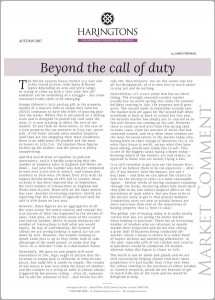The British country house market is a vast and richly varied picture, with many different layers depending on area and price range, so trying to come up with a ‘one-size-fits-all’ comment can be something of a struggle – but some universal truths seem to be emerging.
George Osborne’s 2015 parting gift to the property market of a massive hike in stamp duty land tax (SDLT) continues to have the effect of pouring glue into the works. Whilst this is calculated on a sliding scale and is designed to punish top-end sales the most, it is now starting to affect the rest of the market. To put flesh on those bones, in the case of a £2m property the tax amounts to £153,750; worse still, if the buyer already owns another property (and they are not swapping their main residence) there is an additional 3% payable and the total increases to £213,750. Extrapolate these figures further up the market, and the picture is pretty unappetising.
Add this horrid level of taxation to political uncertainty, and it’s hardly surprising that the number of property sales in England and Wales are down – last year the number was 848,857 compared to well over 2,000,000 in 2006/7, and transaction numbers in 2016 were 7% down from 2015 with the largest decline being an 18% fall in London. More recently it has been reported that in September, the total number of transactions in England and Wales were 63,000, down 20% on the same month last year. Another interesting statistic, Savills are reporting that the amount of agricultural land for sale is 25% down on last year.
However, these figures are an aggregation of all the sales across the entire country and conceal the true picture of what has happened to the volume of sales, £2m plus, in the prime areas of the country and central London, where in many instances the number of transactions is half what you would expect. By way of confirmation, the number of clients we are seeing looking to spend £2-5m are down by 50%. However, the number looking to spend £10m plus is up as they either look to take advantage of the weak pound, or make that big ‘once-in-a-lifetime’ trade to a destination house.
Meanwhile, life goes on and people still need somewhere to live; logic ought to dictate that the increase in stamp duty is reflected in reduced sale prices, but sadly life is rarely so simple. The vendor of one house is also very often the buyer of another, and the catalyst to a string of sales is almost always triggered by the person selling – after all, someone has to sell for someone to buy – and herein lies the rub; the ‘discretionary’ toe-in-the-water sale has all but disappeared, as it is now just so much easier to stay put and do nothing.
Nevertheless, it’s a rare cloud that has no silver lining. The strongly seasonal country market usually has an active spring, but come the summer holidays starting in July, the property world goes quiet. The second week in September usually sees the market kick off again for the second half when everybody is back at work or school but this year, the autumn market has simply not re-started as so few new houses are coming up for sale. However, there is stock carried over from this spring (and in some cases, from the autumn of 2016) that has remained unsold, and very often these vendors are the most focussed sellers in the market today who, having been on their voyage of discovery vis-à-vis what their house is worth, versus what they have been asking, would now really like to sell. This is one of the biggest tasks facing a buyer today – knowing which of the vendors are real sellers, as opposed to those who are merely flying a kite.
It is still essential to get into see the houses first, even if we believe them to be too expensive – after all, if you haven’t seen the houses, you can’t buy them – and then we can advise the clients to wait for the pricing to come to a more reasonable figure. Several weeks of having strangers tramping through the house, muttering about how much work they plan to do, has almost magical affect on the motivation of most sellers. But you have to be in the picture early to get to that pivotal moment. Transaction costs are now so painful buyers are more conscious than ever of the importance of buying property that is ‘best in class’.
The golden rule of buying today is to make totally certain that you are seeing the entire market when looking to purchase. There are an increasing number of vendors who are reluctant to openly market their properties and we are now seeing a great deal of business being conducted off-market, where a house is shown to a select band of buyers without any marketing whatsoever. In the past, typically 40% of our London and country acquisitions would be conducted off-market, whereas today this figure is closer to 70%.
Conclusion
The world is not all doom and gloom and we are still successfully helping clients find their ideal properties; it’s just harder than it has ever been. For advice relating to the purchase of either London or Country property, please do not hesitate to get in touch with any of the team and we would be delighted to help.
By Jamie Freeman

